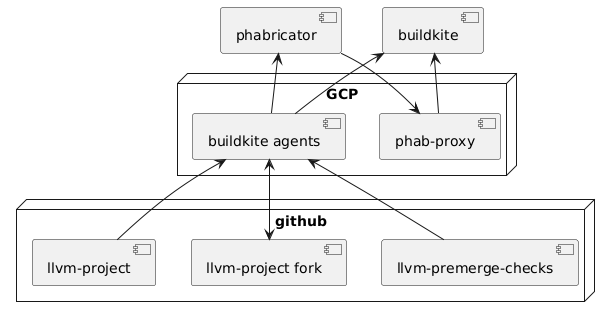90 lines
3.1 KiB
Markdown
90 lines
3.1 KiB
Markdown
# Overview
|
|
|
|
This repository contains the configuration files for the merge guards for the LLVM project. It configures a cluster of build machines that are used to check all incoming commits to the LLVM project.
|
|
|
|
# Merge guards
|
|
TODO(@christiankuehnel): describe objective of merge guards
|
|
|
|
# Cluster overview
|
|
|
|
The cluster consists of these services:
|
|
* Jenkins build server: http://jenkins.llvm-merge-guard.org
|
|
* a set of Jenkins agents running the builds
|
|
* an nginx server with the build results/logs http://results.llvm-merge-guard.org
|
|
|
|

|
|
|
|
# Jenkins-Phabricator integration
|
|
|
|
The Jenkins-Phabricator is based on the instructions provided with the [Phabricator-Jenkins Plugin](https://github.com/uber/phabricator-jenkins-plugin).
|
|
|
|
On the Phabricator side these things were configured:
|
|
* the Harbormaster [build plan](https://reviews.llvm.org/harbormaster/plan/3/)
|
|
* the Herald [rule](https://reviews.llvm.org/H511)
|
|
|
|
On the Jenkins side:
|
|
* in the Jenkins configuration page as explained in the instrucitons
|
|
* in the build [job](http://jenkins.llvm-merge-guard.org/job/Phabricator/)
|
|
|
|
There is no backup of the credentials. If you need to change it, generate a new one and update it in Jenkins and Phabricator.
|
|
|
|
# Playbooks
|
|
|
|
## deployment to a clean infrastructure
|
|
|
|
General remarks:
|
|
* GCP does not route any traffic to your services unless the service is "healthy". It might take a few minutes after startup before the services is classified as healthy. Until then you will only see some generic error message.
|
|
|
|
These are the steps to set up the build server on a clean infrastructure:
|
|
1. Configure the tools on your local machine:
|
|
```bash
|
|
./local_setup.sh
|
|
```
|
|
1. Delete the old cluster, if it still exists:
|
|
```bash
|
|
cd kubernetes/cluster
|
|
./cluster_delete.sh
|
|
```
|
|
1. Create the cluster:
|
|
```bash
|
|
cd kubernetes/cluster
|
|
./cluster_create.sh
|
|
```
|
|
1. Create the disk storage, if it does not yet exist:
|
|
```bash
|
|
cd kubernetes/cluster
|
|
./disk_create.sh
|
|
```
|
|
1. SSH into the VM instance mounting the volume, find the mount point and then set
|
|
```bash
|
|
# go to the mount point of the volume
|
|
cd /var/lib/kubelet/plugins/kubernetes.io/gce-pd/mounts/jenkins-home
|
|
# change the permissions
|
|
sudo chmod a+rwx
|
|
```
|
|
1. Push the docker images to gcr.io:
|
|
```bash
|
|
cd containers
|
|
#for each subfolder:
|
|
./build_deploy.sh <foldername>
|
|
```
|
|
1. Deploy the stack:
|
|
```bash
|
|
cd kubernetes
|
|
./deploy.sh
|
|
```
|
|
1. Configure it
|
|
|
|
## creating basic authentication for reverse proxy
|
|
|
|
1. create auth file, based on [ingress-nginx documentation](https://github.com/kubernetes/ingress-nginx/tree/master/docs/examples/auth/basic)
|
|
```bash
|
|
cd kubernetes/reverse-proxy
|
|
htpasswd -c auth <username>
|
|
# enter password at prompt
|
|
# add more users as required
|
|
kubectl create secret generic proxy-auth --from-file=auth --namespace=jenkins
|
|
```
|
|
|
|
# License
|
|
This project is licensed unter the "Apache 2.0 with LLVM Exception" license. See [LICENSE](LICENSE) for details.
|